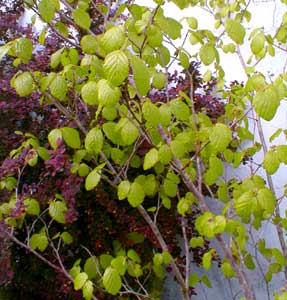 | |
And the dead leaves lie huddled & still,
(1874-1963) | |
American Witchhazel; aka:
Common Witch Hazel,
Snapping Hazelnut,
Snappy Hazel,
Witch Elm,
Spotted Alder,
Striped Alder,
Winterbloom,
Snapping Tobacco Wood
The American Witchhazel (Hamamelis virginiana) grows wild throughout the northeast & southeast of the continent, from Florida to Nova Scotia, from eastern Texas to the Great Lakes, & is particularly abundant in the Appalachians.
Though it has been a garden standard for two hundred years, of late it has to a large extent been displaced in gardeners' esteem by the wide array of Asian hybrid witchhazels with larger blooms & more dramatic autumn leaf colors. But the Asian hybrids have no scent to speak of, whereas the American species has splendid perfume with its winter flowers
In our garden the American species blooms late in autumn/early in winter, with the hybrid 'Jelena' Witchhazel blooming late in winter. Having both in the garden means a very extended period with witchhazels blooming. Furthermore, the American witchhazel is hardier further north than are the Asian hybrids.
So our native witchhazel has become to some degree a displaced citizen, foolishly overlooked in favor of exotic shrubs. Yet our "common" witchhazel is an exotic shrub in Asia, & is today grown in Japan as Amerika-Mansaku, & in China as Chinlu-mei, & has all the respect it deserves, admired for the redolence it brings to a winter path.
And even if it is true the autumn leaf color is more extraordinary for our Asian hybrid, there is yet something to be said for the rich yellow fall colors of the native shrub, as can be seen in the third photo below snapped in September. You can see further autumn portraits on the American Witch Hazel Page of the Autumn leaves gallery.
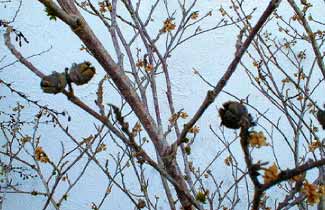 We installed a seven-foot American witchhazel alongside the house & next to our flagstone patio, where we are best be able to appreciate its scented blooms. It stands upright with a single trunk that fans near the base & opens up into a vase shape, with rugged grey branches making it look like it's been there for many years.
We installed a seven-foot American witchhazel alongside the house & next to our flagstone patio, where we are best be able to appreciate its scented blooms. It stands upright with a single trunk that fans near the base & opens up into a vase shape, with rugged grey branches making it look like it's been there for many years.In the wild they grow to thirty feet, though in most gardens ten feet would be more likely, adding height so slowly that fifteen feet would be an awfully long while coming. After five years in our garden, & only slight pruning to keep it from getting to large around for its space, it's still only about six feet tall, though much more deensely foliaged than when first planted.
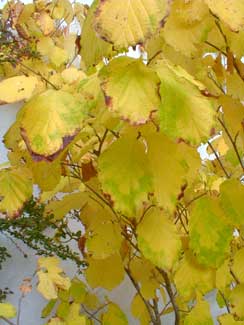 Though trainable as a single-trunked tree, it is naturally a large multi-stemmed shrub. When young to middle-aged, the shrub tends most often to be vase-shaped, but extremely old specimens can be broad & round.
Though trainable as a single-trunked tree, it is naturally a large multi-stemmed shrub. When young to middle-aged, the shrub tends most often to be vase-shaped, but extremely old specimens can be broad & round.Small spidery yellow flowers appear on the naked branches October to December, strappy like little tufts of yarn dangling from tiny yellow star-cup bracts. These blooms are a striking contrast to the smooth grey to light brown wood. In some landscapes, witchhazel provides the only colors for winter. The limbs can be wonderfully crooked, making a pleasing winter impression even before becoming covered with the blooms.
The flowers attract winter moths. The small horned witchhazel nuts develop through the following year & then in autumn "snap" open to cast two shiny black seeds a considerable distance, as far as forty feet having been observed, ten or twenty feet more likely, each nut making a loud "snap!" sound.
In the limb portait above right, some of the boxy horned nuts can be seen still clinging to branches in February. In the Northwest these nuts can be numerous & about half the size of those on the Asian hybrids, so apparently we have the right kind of winter moths for them. Reports from Great Britain suggest they do not produce so many seeds, I would assume because the right sorts of moths are not present to respond to the flowers' scented siren call.
The seeds can be further dispersed by birds, & take a full year to germinate, with growth rate of the seedlings very slow. When seedlings are spotted, they should be transplanted to pots & given some gentle care for a couple of years before selecting a location for them in the ground. It will usually be about six years before it is old enough to flower.
The seeds are reputedly edible, with an oily pistachio flavor, but so small they are never used as food. They were formerly part of Native America's diet, & the French in Canada called the shrub Pistachier Noir, the black pistachio nut, so it would seem the early French trappers enjoyed them.
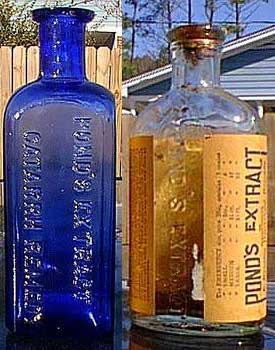 It's a shrub or small tree with quite a history for our continent. Medicinal useage has early reports among the Osage, Cherokee, Potawatomi, Iroquois, & Mohegan.
It's a shrub or small tree with quite a history for our continent. Medicinal useage has early reports among the Osage, Cherokee, Potawatomi, Iroquois, & Mohegan.In the 1840s, an Oneida medicine man showed Theron T. Pond of Utica, New York, how to prepare & use witchhazel as a medicine.
Though most whites in Pond's position would've taken the information for himself & never given a second thought to the source, Pond with vaster honesty entered into a business agreement with the Oneida tribe, & was soon marketing witchhazel under the trade name "Golden Treasure," soon after renamed Pond's Extract. It was America's first mass-marketed toiletry actually made in America.
It came to be used as a daily astringent in most American homes. I remember well my great-grandmother's blue bottles of witchhazel that she used as an after-bath splash for her skin.
Right up to the present day, the Dickensen company of East Hampton sells sundry witchhazel products, including skin care splashes, soaps, & hemorrhoid pads with witchhazel & aloe. For broader discussion of values & restrictions, see the separate article on Medicinal Uses of Witchhazel.
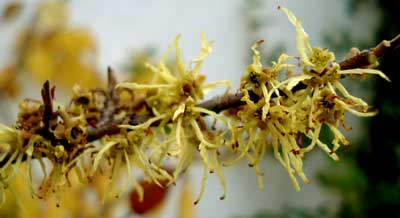 The origin of the name witchhazel is not entirely certain. How it came to be called a hazel is not hard to guess. Although not a member of the hazel family, the leaves do resemble the leaves of hazels, & then there's that horned nut which can be fancied as a tiny almost box-shaped version of a hazel nut.
The origin of the name witchhazel is not entirely certain. How it came to be called a hazel is not hard to guess. Although not a member of the hazel family, the leaves do resemble the leaves of hazels, & then there's that horned nut which can be fancied as a tiny almost box-shaped version of a hazel nut.But why "witch" is more obscure, though a leading theory associates witchhazel with water dowsing or divining. It became the shrub of choice for obtaining forked limbs for water-dowsing, so it is thought the name became attached to the shrub because of its use by "water witches" in detecting groundwater.
The idea that witchhazel limbs could be used to find groundwater may have begun with the Mohegan Indians, & white immigrants observed its use. "Wicke" is Middle English for "lively" & "wych" is an old Anglo-Saxon word for "bend." The shrub may have been dubbed a Wicke Hazel by the pilgrims because the dowsing end of the forked limb became "lively" & bent downward when the dowser carried it over ground with water beneath.
It's also conceivable the pilgrims thought it "lively" merely for being so in winter when it blooms & snaps its seeds, & being "bent" alluded to the zigzagging twigs & limbs.
There are no early records to definitively explain this old name. Although the prevailing theory is that the name was corrupted over time to Witch despite that it originally meant something else, it may just as well have been Witch from the start. There was an old belief that a tea made from the leaves & bark of witch hazel could be imbibed to heighten occult powers. The leaves were traditionally used for a tonic tea even before the arrival of white immigrants, but the idea of an occult factor may have been inspired much later by the shrub's name, rather than being named for such beliefs.
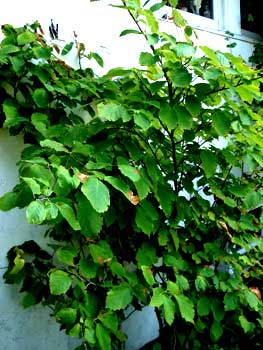 In England there is an elm (Ulmus glabra) which was itself sometimes called a witch hazel tree even in the time of the pilgrims. So early white immigrants may only have looked about for something local which could have the familiar name. Some have even suggested that water-dowsing was already known in England, & the tree of choice was that very elm.
In England there is an elm (Ulmus glabra) which was itself sometimes called a witch hazel tree even in the time of the pilgrims. So early white immigrants may only have looked about for something local which could have the familiar name. Some have even suggested that water-dowsing was already known in England, & the tree of choice was that very elm.More certainly pilgrims observed Indian dowsing, which was very soon adapted by white immigrants to North America, then exported to Europe. It became a permanent & essential feature of well-digging until well into 20th Century America, & is practiced less rigorously even now in the 21st Century.
I remember as a child that my maternal great-grandfather, a Yakama Indian, dowsed before digging a well, though being a Northwesterner, I believe he used a willow, not a witchhazel. He taught me to dowse, first by letting me hold one side of the forked branch while he held the other, then by letting me do it myself. I was very little, however, & only enjoyed it as a game. I afterward many times walked about with a dowsing rod & often felt the tug downward, but even as a child had the feeling of self-hypnosis, & was no more convinced it honestly worked than I was convinced of Santa Claus.
Until the era of municiple water systems, dowsing was regarded essential for increasing the odds of finding water before undertaking the arduous work of well-digging. Many people to this day believe in water-dowsing. Dismissing them as superstitious hicks would be an error. A ten-year study overseen by Professor Hans-Dieter Betz, a physicist at the University of Munich, had its results published in the peer-reviewed scientific Journal of Scientific Exploration, Stanford University, March 1995.
In Professor Betz' study, two-thousand dowsing cases prior to well-digging were observed in Sri Lankha, Zaire, Kenya, Namibia, Yemen & other countries. Conventional hydrogeological methods of finding water provided the "control" group, with established success rates in the 30 to 50 percent range. The success rate of dowswers in Sri Lankha was 96 percent. Dowsers even predicted water depth with amazing accuracy. Nearly all cases occurred in sites where random drilling for water had low success rates.
No "rational" explanations such as chance & lucky guesses could account for the phenomenon. Betz's research is by no means definitive & being a respectable professor doesn't rule out of the possibility of crackpotism; he notes that Sri Lanka has 100 to 200 inches of rainfall a year, which might alone explain a high success rate to dowsing, & Professor Betz' insistence that other methods have poorer luck is not actually substantiated by anything but his say-so.
And yet more such research could be cited -- although, alas, even more studies could be cited that show dowsers' luck to be no greater than chance. Nevertheless, there remains a haunting insinuation that well-digging companies should include water-dowsers in their overall systems to improve their odds of success not just a little more often, but evidently by an enormous factor. For as Professor Betz concluded, "We have established that dowsing works, but have no idea how or why."
Very adaptable to most garden situations, the ideal spot for the American Witchazel is a protected, semi-shaded locations with rich soil & regular watering. It may suffer in too much sun, being in nature an understory shrub, sometimes forming a secondary solid story below large trees of eastern old-growth forests.
A 1976 study showed that after logging, the witchhazel population suddenly exposed to full light dies off rapidly. Our witchhazel is against the house so fully shaded in the morning side, & afternoon sun was dappled its first couple years, but after the removal of a cherry tree became very harsh afternoon sun. It has not seemed to suffer.
So in the open gardens of the mild Northwest, it often does perfectly well in sunnier locations, & if gardened in an area with too much shade, the autumn leaf colors will not be as striking. They can also survive in cold regions with winters down to minus thirty-nine F., but in the more northerly reaches would require protection from dessicating winter winds.